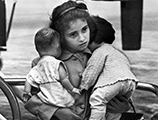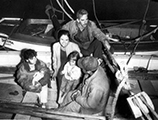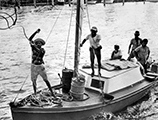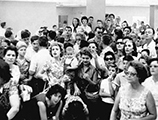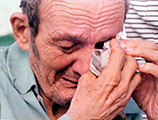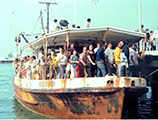The Cuban Experience in Florida: Revolution and Exodus
Lesson Plans
Cuban Refugees Arriving in Florida (photographs)
Information for Teachers
Overview
Since 1959, over one million refugees have fled Cuba for the United States, particularly South Florida. With this primary source set, students can analyze photographs in order to write about the Cuban refugee experience. Students will strengthen their skills in analyzing primary sources and learn how events in Florida history relate to United States history.
Photographs Set 1: Revolution and Exodus, 1961
The Photographs
Background Information
The photographs above were taken in 1961 and 1962 during the early stages of the Cuban exodus to the United States following the Revolution of 1959. By October 1962, nearly 250,000 Cubans had left the island for the United States. Cubans arrived in the United States with little more than the clothes on their backs. Many sought assistance from the Cuban Refugee Assistance Program (CRA). Authorized by President John F. Kennedy in 1961, the CRA provided short-term assistance in order to help Cuban refugees obtain food, shelter, and clothes. Longer-term assistance from the CRA was available for health, employment and educational training.
These photographs depict different aspects of the Cuban refugee experience. Teachers should prompt students with contextual information on the Cuban revolution and the refugee crisis of the early 1960s. Students should then write about the photographs based on what they know about the history of Cuban immigration.
Use to Illustrate:
The experience of Cuban refugees traveling to the United States in the early 1960s.
Questions for Students
Based on these photographs, describe the experience of Cuban refugees during the early 1960s.
Sample Answers
(Answers will vary. Teachers should encourage students to elaborate on what they see in the photographs, how these images make them feel, and how they provide insight into the experience of Cuban refugees in the early 1960s.)
Additional Relevant NGSSS
- SS.912.A.7.16: Examine changes in immigration policy and attitudes towards immigration since 1950.
- SS.4.A.8.2: Describe how and why immigration impacts Florida today.
- SS.912.A.7.11: Analyze the foreign policy of the United States as it relates to Africa, Asia, the Caribbean, Latin America, and the Middle East.
- SS.7.C.4.3: Describe examples of how the United States has dealt with international conflicts.
Florida Standards:
- LAFS.K12.R.3.7: Integrate and evaluate content presented in diverse media and formats, including visually and quantitatively, as well as in words.
Photographs Set 2: Mariel Crisis, 1980
The Photographs
Background Information
The above photographs were taken during the Mariel Boatlift of 1980. The relaxation of Cuban-U.S. relations in the late 1970s inadvertently increased pleas from Cubans wishing to leave the island and join relatives in the United States. In April 1980, amidst growing international criticism following an incident at the Peruvian Embassy in Havana, Fidel Castro opened the Port of Mariel to refugees wishing to leave Cuba. On April 20, hundreds of boats approached Mariel on Cuba’s northern coast. Cubans living in the United States chartered boats and made the perilous journey across the Florida Straits in hopes of finding their relatives. By May, the flotilla numbered in the thousands. Between April and October 1980, 125,000 Cubans left Mariel.
This latest wave of refugees, known as Marielitos, arrived in Key West aboard crowded vessels. Refugees with relatives already in the United States were the first to be processed and released. Those without relatives were relocated to tent cities in Dade County and detained for several months. Not all desiring to leave Cuba via Mariel made the journey. The Cuban government prevented many individuals from leaving during the Mariel boatlift.
Cubans already living in Florida generally looked down upon the Marielitos. Rumors circulated that Castro, wishing to rid the island of criminals, had simply opened Cuban jails and shipped the inmates to the United States. Popular films such as Scarface (1983) helped perpetuate this stereotype. Academic studies of the Marielitos proved these rumors to be exaggerated. In fact, only 4% of the Marielitos had criminal records. Of these, many had been imprisoned for political reasons.
Use to Illustrate:
The experience of Cuban refugees traveling to the United States in 1980 during the Mariel Crisis
Questions for Students
Based on these photographs, describe the experience of Cuban refugees during the Mariel Crisis.
Sample Answers
(Answers will vary. Teachers should encourage students to elaborate on what they see in the photographs, how these images make them feel, and how they provide insight into the experience of Cuban refugees during the Mariel Crisis of 1980.)
Additional Relevant NGSSS
- SS.912.A.7.16: Examine changes in immigration policy and attitudes towards immigration since 1950.
- SS.4.A.8.2: Describe how and why immigration impacts Florida today.
- SS.912.A.7.11: Analyze the foreign policy of the United States as it relates to Africa, Asia, the Caribbean, Latin America, and the Middle East.
- SS.7.C.4.3: Describe examples of how the United States has dealt with international conflicts.
Florida Standards:
- LAFS.K12.R.3.7: Integrate and evaluate content presented in diverse media and formats, including visually and quantitatively, as well as in words.

 Listen: The World Program
Listen: The World Program